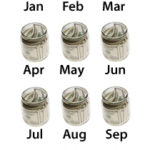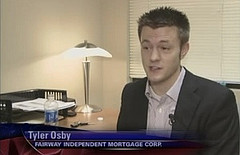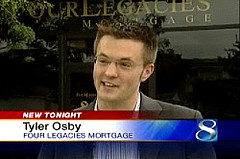Let’s start out by turning the tables here and putting you in the position of a bank. Say someone comes to you and wants to borrow money on a house. They say want to put borrow 100% and put absolutely no money down. They’ve never owned a home before, but they’ve had a few credit cards that are in pretty good standing. It seems like they could re-pay the debt, but they really don’t have much (if anything) to loose if they stop making payments.
Do you lend that individual $150,000 to buy their first dream home? Would you just keep your fingers crossed and hope that they repay your loan? Unfortunately it only would take YOU one time getting burnt and you’d realize that’s pretty risky business and get out.
Going back into history (before 1956 to be specific) banks would not lend over 80% of a homes value. The reasoning behind that is banks would loose money in a forclosure situation. Normally when banks go to sell forclosure properties, they are in poor condition and the bank wants to get it off their books quickly (after all, they are in the business to collect payments – not manage properties). The bank often ends up selling for 80% of the homes original value. This risk is why banks required buyers to have 20% down when purchasing a home.
In 1956 a new industry was born, Private Mortgage Insurance (PMI). PMI allowed banks to take less than a 20% down payment and still fund the loan. PMI was in place to insure the amount lent over 80%. At first PMI allowed buyers to finance up to 85%. By 1971 buyers were able to borrow up to 95% of their new homes. Private mortgage insurance allowed banks to make buying a home possible for more Americans and took homeownership to an all time high of 64.5%.
The addition of PMI helped banks in two respects:
- More money being lent helped increase the banks profits.
- The borrower (homeowner) was paying for the bank’s insurance policy (the PMI).
Private mortgage insurance companies are in place to make higher loan to value (LTV) loans possible. The lender will require a borrower to pay for a mortgage insurance policy on the loan until the LTV reaches 78%. If the borrower ends up in default on the loan, the lender will be reimbursed by the mortgage insurance company.
PMI is a lot like your automotive insurance in some respects. The higher risk you are, the more your insurance policy will be. Some factors of the rate you might pay are:
- Credit Score
- Amount of Money You’re Putting Down
- The Specific Mortgage Program
- Level of Approval From The Lender
- Coverage Requirement From The Lender
- Amortization Term (15yr vs. 30yr.)
- Fixed or Adjustable Rate
It’s also important to acknowledge there have been new additions to the mortgage market since PMI came around. Here are other alternatives, they will be explained in further detail in later blog posts:
- Lender Paid Mortgage Insurance (LPMI)
- 80/20 Loans (2nd Mortgages)
- Seller Carry Back Mortgages
If you have further questions in regards to subject of mortgage insurance, always feel free to contact me!









